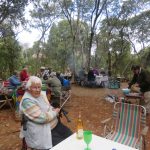TREE LIFE
AUGUST 2022
504
Hi Everyone,
In August we shall have a Tree Outing to the home of Pauline Ballinger, Saturday afternoon August 27th, meet there at 2pm.
Directions: From Samora Machel Ave, turn left into Rhodesville Ave. Proceed for 2.9 kms and turn right into Clifton Road. Clifton Road is signposted on the walls. The turn off is at a point where a Jacaranda on the right of the road touches an Acacia growing on the left of Rhodesville Ave. Number 16 Clifton Road is on the right hand side of the road. We will drop a pin by WhatsApp nearer the time to enable members to find the venue easily.
Tomorrow morning there will be the usual first Saturday of the Month Tree Walk in the Botanical Gardens on 5th Street Extension.
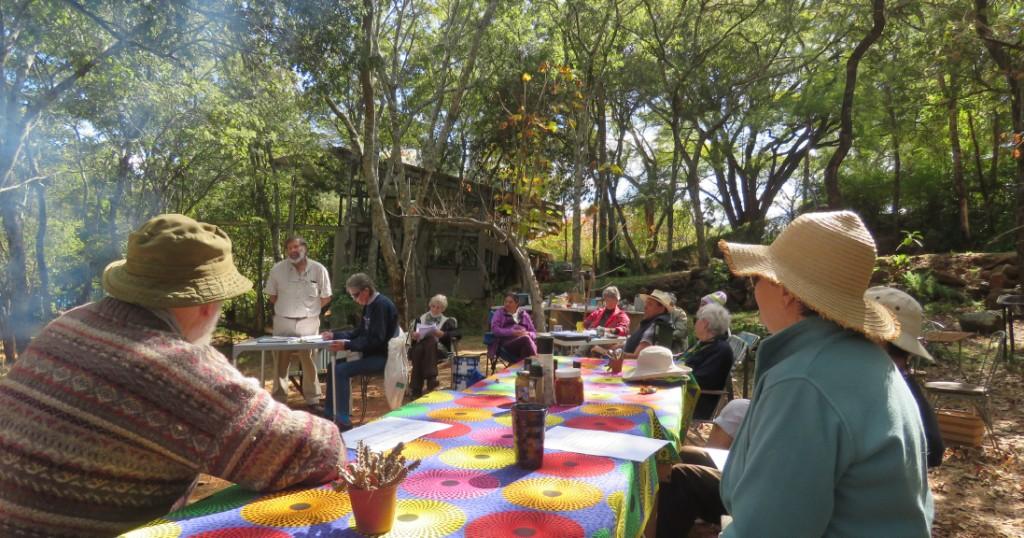
72nd AGM in session Photo by Rob Jarvis
CHAIRMAN’S REPORT 2021-2022 (72nd AGM)
Welcome to the 72nd Annual General Meeting of the Tree Society of Zimbabwe. I have pleasure in presenting my seventh annual Chairman’s report covering the year 1st April 2021 to 31st March 2022.
Tree Outings: As you know the Covid-19 lockdown has eased off and our monthly outings are back. As far as I can remember, we only had one out of town outing to Summer Island in Ruwa. Just a reminder that sometime in the past, at a committee meeting, we reduced the number of outings to be just two per month. We now have the first Saturday morning outing to the National Botanical Garden and either a 3rd Sunday morning outing or a 4th Saturday afternoon outing. With Covid still around, we are still keeping groups small, so we only invite our members and do not advertise any of our outings to non-members. Besides meeting at the National Botanical Garden nearly every month, we went to four private properties in Harare and managed two out of town outings to Christon Bank and Summer Island in Goromonzi. Many thanks to the residents of these properties for hosting us.
Tree Leaders: We are short of leaders and would really like a few more, any volunteers? You don’t have to know everything as whoever is participating can “chip in” and make the outings even more special!
Weekend Trips: Due to the Covid-19 lockdown we didn’t have any weekend trips in the last year.
Tree Society Facebook group: Since last year the group membership has increased by over 500 and now stands at over 5000. Mark Hyde looks after our Facebook page.
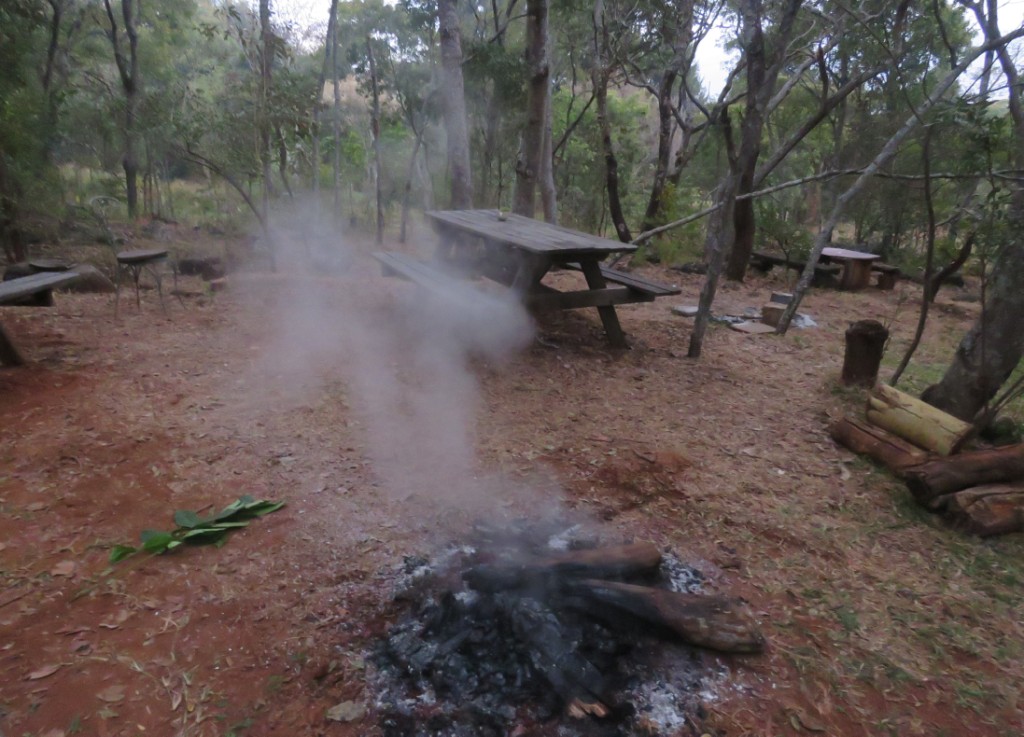
Party Aftermath Photo by Rob Jarvis
Tree Life: Rob Jarvis is now the editor of Tree Life and we now have a new look newsletter. Although Mary has had some personal medical issues, she still manages to put some Tree Lifes onto our website. Not only that, when material was short, she found interesting stuff in past newsletters.
We have not had too many new contributors in the last year. Now all of us are capable of writing a story and I’m sure there are many tree related interesting/funny stories out there. We need your stories and don’t worry about the English – it can always be fixed! Thanks to those who contributed write-ups on our outings and articles for Tree Life – in order of appearance: Ryan Truscott; Tony Alegria; Mark Hyde; Ian Riddell; Jan van Bel; Ann Sinclair; Dawn Siemers; Meg Coates Palgrave (Taken from Tree Life 2 May 1980); Kim Damstra in Tree Life No.47; Lyn Mullin (Tree Life No. 251); Rob Jarvis / Mafungi and Mary Toet.
Apologies to anyone I may have left out. For the past few months, Rob Jarvis has been the main contributor – in fact some issues had only his articles. Many thanks Rob. We need more members to be able to put a Tree Life together so we can have more depth, you do not have to be a computer expert to do this. If you are interested, let me know.
Finances: The financial position of the Society remains satisfactory. The accounts and balance sheet were prepared by Bill Clarke. Bill looked at the society’s needs and set the annual subscriptions to what they are now – anyone paying later on will probably pay more as the subs. will be adjusted as needed depending on inflation.
Tree Society Website: During the year, besides getting all the Newsletters totally up to date, quite a few pages have been added to boost the website. We now have a Gall Gallery and ask you to look at it and also contribute photos. I still would like to have flower and spectacular tree galleries. In the last year we had 133 countries visiting the website and as you would expect, the majority of hits (52.97% of 11,417 hits) came from Zimbabwe.
The problem with the website is that we only have two members who are able to do anything on it, so we desperately need more members to be able to do some stuff. If you can do Email, Word and Excel, you are certainly able to learn to do things on the website! Ideally we should have a number of members able to work on the website who would become a sub-committee and decide on things like: what should be added/ deleted/ amended and then be able to do whatever has been decided.
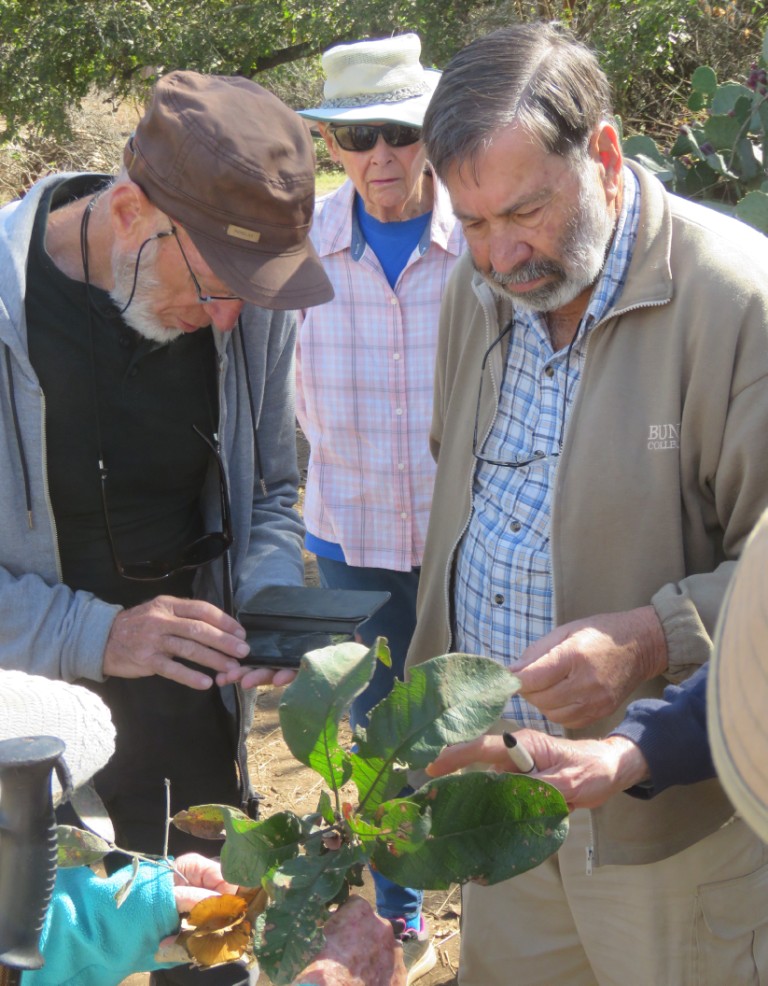
What tree is this?
Photo by Rob Jarvis
Tree Labeling: No work was done on this project in the last year mainly due to the pandemic but I am trying to increase the National Botanical Garden list from 300 to 325 trees. I am waiting for Chris Chapano to give me the Shona names for the additional 25 trees which will fill the gaps in the present pamphlet with no need for extra pages. The new 325 tree pamphlet will be emailed to our members once finalized and should be available at the entrance gate for a fee. Unfortunately, we have lost a few trees in the National Botanical Garden and these need to be replaced on the list.
Herbarium fumigation: Fumigation of the National Herbarium was carried out twice last year. Herbarium staff report that after fumigation, dead bugs are to be seen.
Christmas Party: Every year attendance has dropped and the committee felt that we should combine the Xmas Party as a social after the AGM. This we did last year and although attendance wasn’t that great, those who attended enjoyed themselves. Basically what we have done is to get away from the rainy season and stopped competing for attendance with other Xmas Parties. Today’s social is very different with a poitjie and sides very kindly organized by Rob Jarvis and also thanks to Rob for organizing the scavenger hunt and the use of his property.
Membership: As at the end of March 2022, we had 108 members, comprising ordinary, external and honorary members. This is a decrease on last year’s numbers – down by 10. We probably now need to have a membership drive.
Committee: During the year, Mary stepped down from the committee and being Tree Life editor. Mary does still put Tree Lifes onto the web site. I’m pleased to state that Rob Jarvis took on the role of Editor and has since become our Vice-Chairman. The current committee now consists of the following seven people: Ann Sinclair, Bill Clarke, Teig Howson, Ryan Truscott, Rob Jarvis, Jan van Bel and myself.
Honorary Membership: Sometime back, the committee decided that anyone who has been a committee member for 10 years deserves to become an Honorary Member. Well Bill Clarke has been on the committee for twelve years now so he automatically becomes an honorary member. Thanks Bill for all your work and contributions to the Society. We also award Honorary Membership to anyone who has done a tremendous amount for the Society. Mary Lovemore has done just that with all the stuff she did for the website. Well done Mary – your hard work is much appreciated. So, now we have two more honorary members!
In conclusion … We have had another very interesting year!
Thank you.
Tony Alegria
Visit to Patrick Mavros
Sunday 17th July 2022
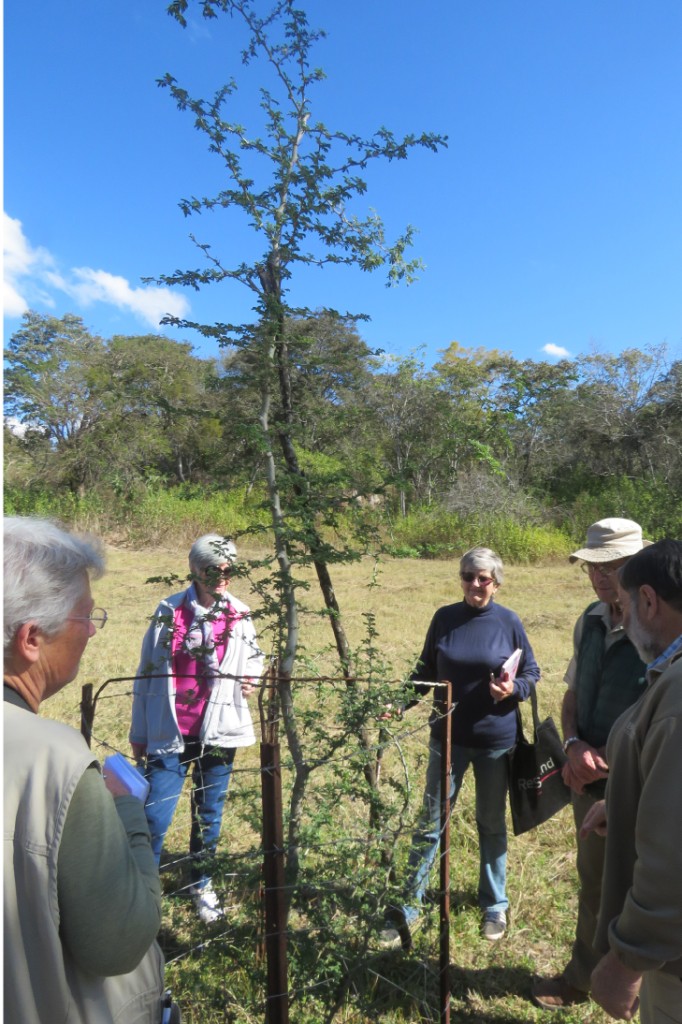
Faidherbia albida protected from animals Photo by Rob Jarvis
A wonderful outing to an amazing piece of miombo woodland within the city limits of Harare, but could easily be out in the districts. Umwinsidale is an area of rolling hills and hidden valleys and the property owned by the Mavros Family is being maintained as Nature intended, with non-indigenous flora being removed wherever possible.
Our guide, Richard Harland explained that even indigenous trees that come from other habitats are being removed so that eventually the property will reflect typical highveld bush and to the left we see members surround an errant Faidherbia albida that had been incarcerated in a makeshift fence, pending judgement day. This one apparently has been spared, even though naturally they only occur in hot, lowland riparian environments in Zimbabwe.
Commonly known as the ana-tree or winter thorn, Faidherbia characteristically loses its leaves in summer and comes out in new foliage with the onset of winter. The young tree we looked at was behaving true to type and had fresh green leaves on the balmy winter’s day.
Let’s hope it gets a permanent stay of execution!
The long list of trees seen include Terminalia mollis, Julbernardia globiflora, Pseudolachnostylis maprouneifolia (duiker berry), Acacia polyacantha, Psidium, (guava), A. sieberiana, Dodonaea viscosa (sand olive), Piliostigma thonningii (Camel’s foot or monkeybread), Erythrina abyssinica and lysistemon, Combretum zeyheri, Euclea natalensis, Ziziphus mucronata, Syzygium cordatum, Ochna schweinfurthiana, Vernonia spp., Lantana camara, Peltophorum africanum (African wattle), Pavetta schumanniana, Vangueria infausta, Ficus sycomorus, Maytenus spp., Gymnosporia buxifolia (common spikethorn) Gymnosporia senegalensis (confetti spikethorn), Strychnos spinosa (spiny monkey-orange). We were pleased to be able to positively identify the Khaya anthotheca, red mahogany, which looked very out-of-place in a miombo/grassland complex ecosystem.
We had a good turn out of some 20 members, ably led by Chairman Tony Alegria with back-up from the technical experts, Meg Coates-Palgrave and Karl van Laeren. No doubt the vastly improved blue-sky weather interspersed with white fluffy clouds encouraged everyone to break away from their cosy fireplaces!
A fascinating development noticed by Meg Coates-Palgrave was this proliferation of adventitious roots coming from a recently cut end of a root-branch on a Ficus burkei growing just next to the road we walked along.
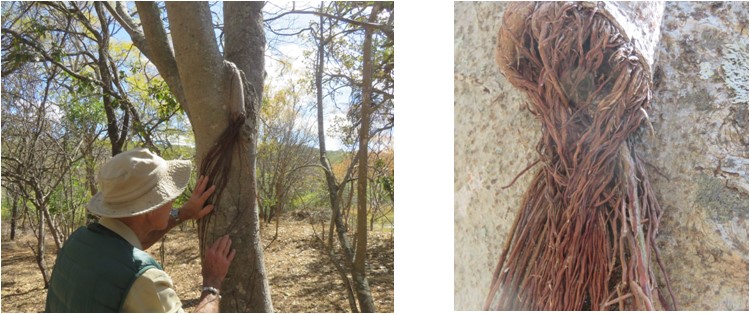
Adventurous aerial roots of Ficus burkei
Photo by Rob Jarvis
Our guide, Richard Harland explained that he had cut the chunk of root/stem off and it had taken as a truncheon to his garden. The originating tree has since responded by pushing out all these little rootlets down the stem of the mother tree. Eventually they will reach the ground and further strengthen the platform that holds up these figs. I know at our house at Rockyvale we once noticed one of these thread-like roots coming down from 3 metres up the fig-tree trunk. We built a structure upwards out of bamboo, filled some open ended bags with soil and let the rootlet find soil and moisture. In no time we had a huge strong root formation that we planned to develop into a living bridge across a rockery in our front garden. However the best laid plans of mice and men were thwarted by us building a new house, renting out the old one and the then tenant didn’t like the untidy bamboo structure holding up our nascent living bridge. We had delusions of grandeur, hoping to cross the front lawn, up the Kenya coffee shade tree and build a tree-house some 40 metres above ground out of the rampant fig roots. We would then be able to clamber up the roots with a backpack full of beers, biltong and dried wors and comfortably watch the rugby across the road at St. Johns every weekend.
Of course mankind tampers with the ficus species at his peril. Too near a house, perimeter wall, roadway, swimming pool, tennis court and beautiful structures can be torn up, cracked to the very foundation and even result in the collapse of once-proud buildings, roadways and parking lots.
The once very grand, Grand Hotel in Beira, Mozambique has a number of figs growing all over it and it looks a very sorry sight the last time I saw it. In Nigeria, where I used to regularly go on business, there were many even more grandiose projects that were now almost indistinguishable in the equatorial jungles and whose edifices have been taken over by advance invasion parties of figs that breach the concrete walls and rooves. Once they are in, all manner of plants follow, filling up every available space with rampant plant life.
National Botanical Garden walk 2nd July 2022
by Ann Sinclair
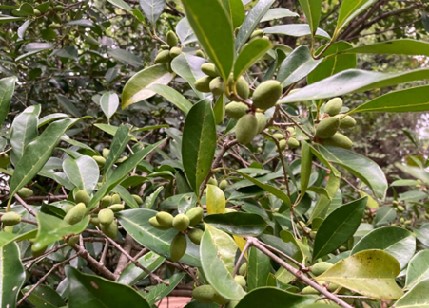
Chionanthus battiscombei Photo by Ann Sinclair
A beautiful crisp, cold morning but sadly I was the only one.
I wandered down the path towards the tearoom The Homalium abdessammadii, the small tree is struggling, but it has been pruned and is sporting some nice new growth.
Here it is growing way out of its habitat. We saw large trees on the banks of the Zambezi, so our poor tree has battled with little water.
Further along were several Chionanthus battiscombei, full of fruit.
Walking towards the Herbarium are the Erythrina livingstoniana with their distinctive rough bark, this year they flowered and now have lots of pods.

Erythrina livingstoniana bark & pods Photo by Rob Jarvis
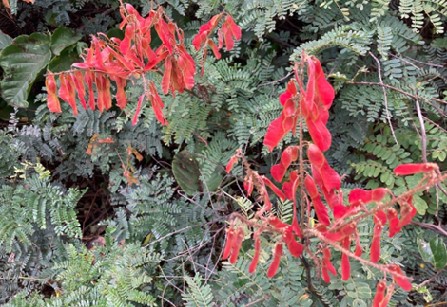
Pterolobium stellatum Photo by Ann Sinclair
The Pterolobium stellatum was a magnificent sight with masses of red wing pods.
This is a climbing shrub which forms dense impenetrable thickets on forest margins and often on termite mounds.
The fruit on the Ziziphus mucronata, which we discussed last month, has yellowing fruit starting to drop. Just a few observations.
Tree Society Committee and Contacts
Chairman Tony Alegria tonyalegria47@gmail.com 0772 438 697
Vice Chairman Rob Jarvis bo.hoom52@yahoo.com 0783 383 214
Honorary Treasurer Bill Clarke wrc@mweb.co.zw 0772 252 720
Projects Jan van Bel jan_vanbel@yahoo.com 0772 440 287
Venue Organiser Ann Sinclair jimandannsincs@zol.co.zw 0772 433 125
Tree of the Month Ryan Truscott ryan.kerr.truscott@gmail.com 0772 354 144
Secretary Teig Howson teig.howson@gmail.com 0772 256 364
Just lately some of the WhatsApp Groups I am a member of have been awash with horror stories about alien invasive plants, and in particular trees, that have become an absolute terror to the landscape where they don’t belong. The most well known recently is the bee bush, Vernonanthura polyanthes, which is terrorising the Eastern Highlands and threatening to swarm over all tracts of indigenous woodlands and grasslands. It was introduced by a do-gooder in the Sussendenga area of Mozambique, inland from the Chimanimani mountains and it has spread rapidly westwards and is a real threat in Chimanimani, Bvumba and adjacent areas, It originally came from Bolivia/Brazil.
We live on the well known ART Farm just on the outskirts of Harare, past Pomona and on arrival here nearly two years ago, I was surprised at the lack of indigenous trees to be found and the number of foreign trees that had either been planted or have escaped and established themselves in our environment. We are implementing a policy on the Farm of planting up Biodiversity hotspots in and around the crop lands to encourage the proliferation of functioning ecosystems where pest-predator populations can co-exist and the latter help to control pest outbreaks as they occur. At the same time we are having a phased removal of the non-indigenous trees that were planted by various land-owners over the years. Where appropriate we will plant indigenous trees either in copses or random groupings rather than having the formal road-lined frontages so commonly seen on commercial farmland. This coming spring/summer we will plant many hundreds of trees in the pastures and paddocks where we run our cattle and fill areas along boundary fences and odd corners around fields with these diversity hotspots. Trees will not be the only plantings and herbaceous plants, grasses and legumes will be part of the mix.
Biodiversity Rules!
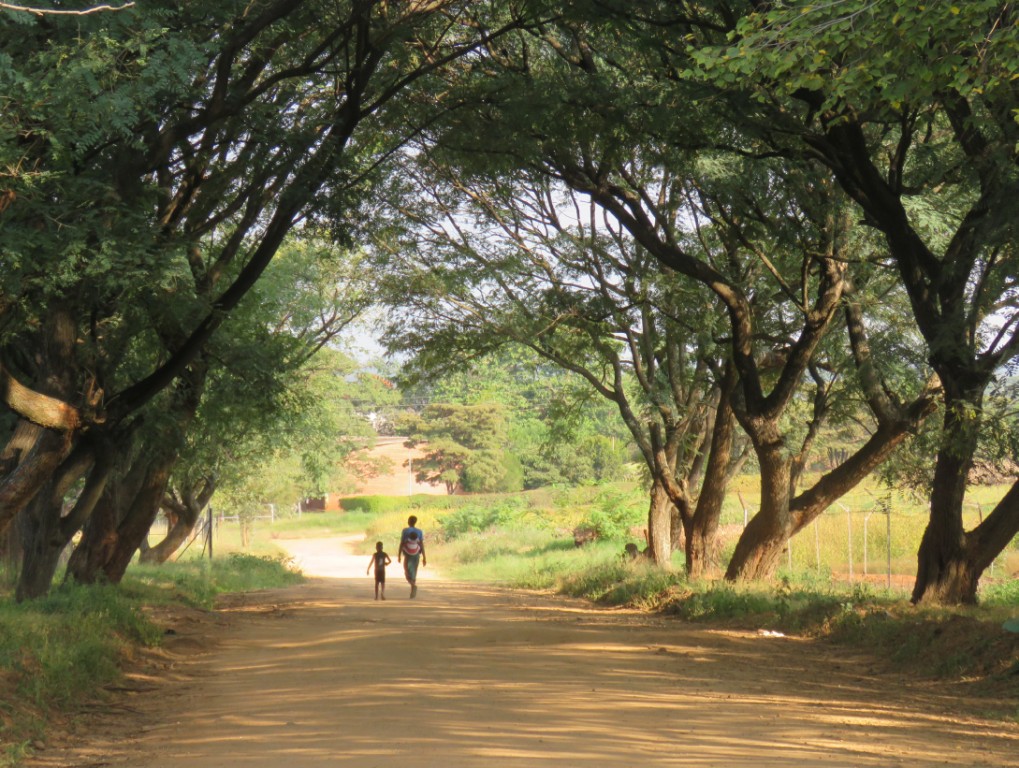
Formal road-lined frontage Photo by Rob Jarvis


